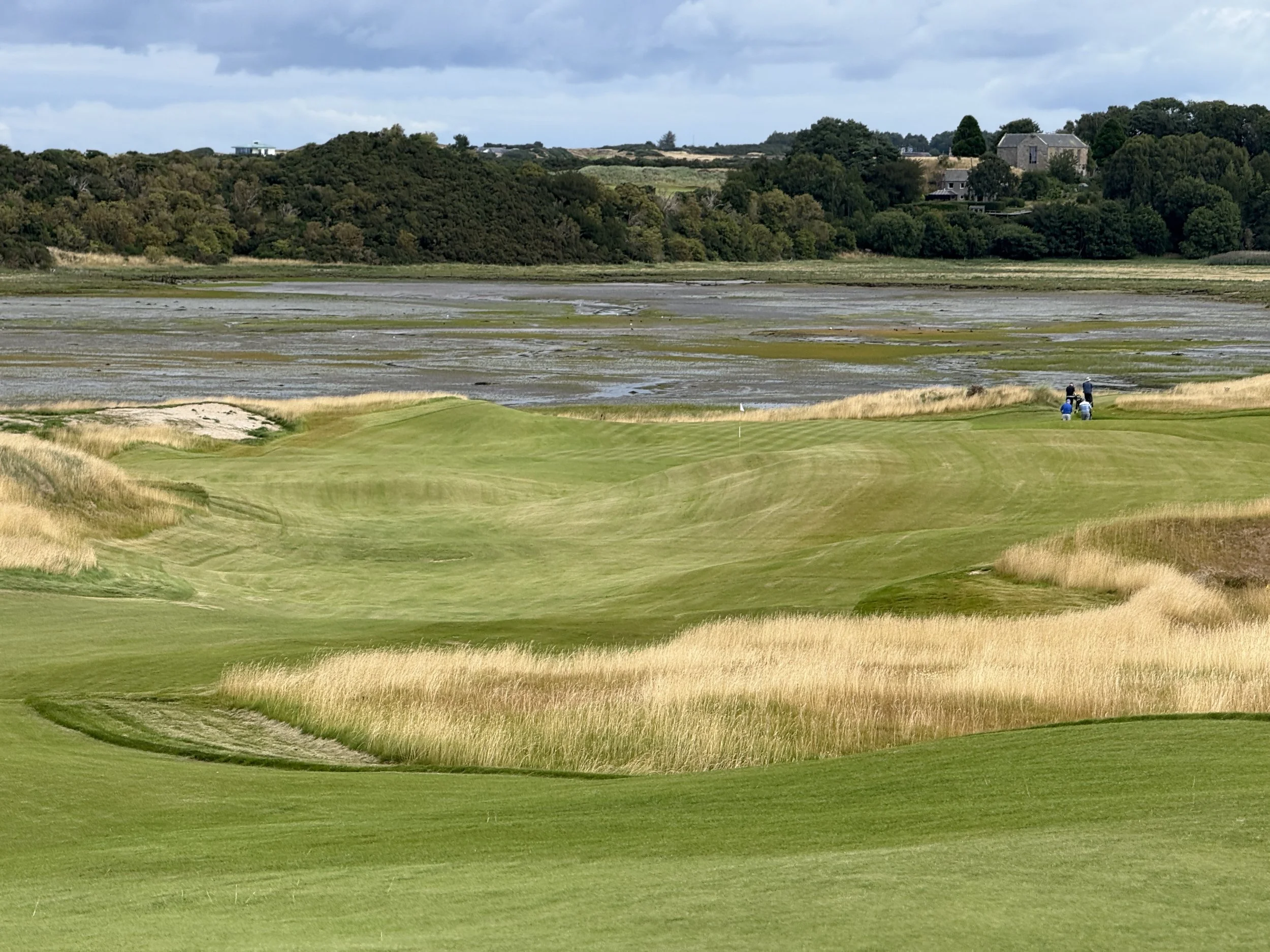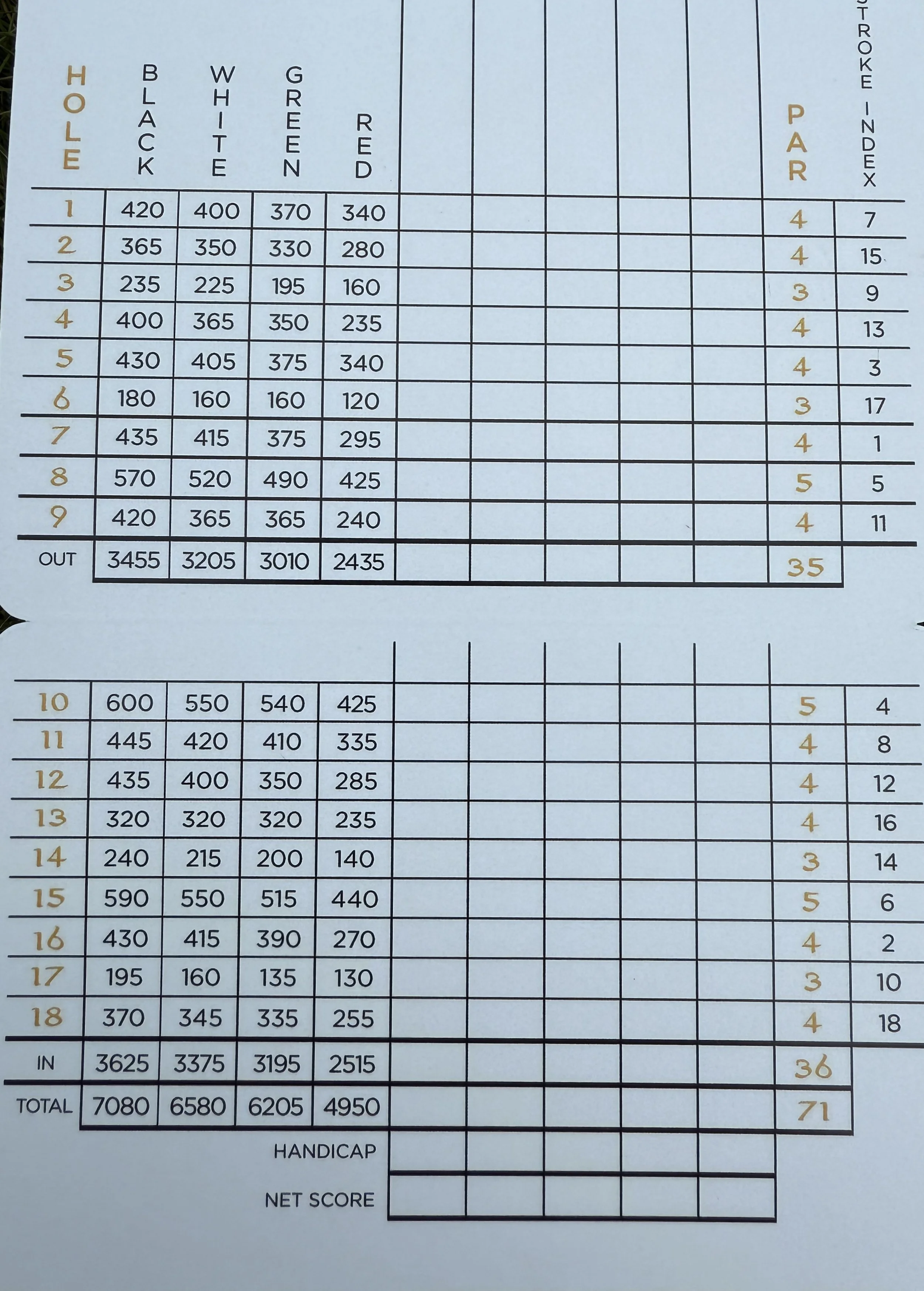The 10th hole at Old Petty
New golf courses in Scotland are like buses - you wait ages for one to arrive and then two come at once! This week has seen the arrival of both the New Course at Trump International and Old Petty at Cabot Highlands.
They have taken very different launch approaches. The Aberdeen course had the President of the USA, the Chief Executive of the European Tour and Scotland’s finest living golfer getting things underway. Old Petty went for a slightly lower-key approach.
Between now and the end of September, any member of the public can play Old Petty if they are playing the original Castle Stuart course too and yesterday’s tee sheet was busy with resort visitors keen to see Tom Doak’s much awaited Scottish creation.
This is still being positioned as preview play, which is reflected in the reduced green fee of £190, before the course is officially opened next May. However, there is no doubt the course is ready to be shown to the world.
Everyone playing Old Petty during preview play will get their own number!
This land had been earmarked for a golf course for some time. Arnold Palmer had developed plans years ago, but when Cabot took over the Castle Stuart property in 2022 they took a different direction. They immediately announced the creation of a second course, with Tom Doak as the architect.
Doak had previously created two courses in the British Isles - The Renaissance Course opened in East Lothian in 2008 and St Patrick’s Links at Rosapenna in Donegal in summer 2021.
I think it’s fair to say that there were different reactions to the two courses. St Patrick’s Links has been heralded as a modern masterpiece. Doak was given a free rein by the owners to create the best course he possibly could, and it shot straight into the GOLF Magazine World Top 100 and has since risen to the top 50. The Renaissance had a slightly more muted response. The brief there had been to create a tough course which could host a PGA tour event. It succeeded in that respect but has never really won the affections of the Scottish people.
Given this background, there will be many eyes on Old Petty. Which type of Doak course would Scotland get this time?
Well, fear not. He has delivered a course which will both delight the Doakistas and please the resort guests. For many Brits, this will be their first experience of a Doak course and they will get a great insight into what has made him the most successful architect since the Second World War.
Firstly, a little about the site. The course is built on what was mainly farmland, so it isn’t what you would call true links terrain. However, under the topsoil, the land turned to gravel and sand, which now forms the base for Old Petty.
Some would say that it’s a lot easier to build a course which ranks highly when you have the benefit of a beautiful setting. From Cape Wickham in the Bass Straits, to Lofoten Links in the Arctic Circle, debates rage as to whether courses are lauded because of their stunning settings or architectural grace. Take the coastline away and it can be harder to impress the ‘retail golfer’.
This site doesn’t have the same spectacular views as next door’s Castle Stuart where you have sensory overload of infinity greens and sweeping vistas of the Moray Firth. This land is mainly away from the water.
On some holes at Old Petty, Castle Stuart Bay estuary comes into play. You play alongside it on the 4th before playing to, and then alongside it, on holes 13-15. But it is not in any way a coastal course.
The par 3 14th tumbles down to the estuary
Instead, there are plenty of structural features to keep you visually interested. The third hole plays alongside Castle Stuart itself. Indeed, if they were going to start naming the courses from scratch I imagine this one would be the Castle Stuart course as it is visible from so many holes on the course, but let’s not confuse things further!
Castle Stuart looks over the par 3 3rd hole at Old Petty.
There is a very cute bothy with a bright red roof behind the fifth green, similar to that on the Eden course in St Andrews, which acts as another navigation point. Throw in a lovely dry stone dyke (wall) behind the third green, and another at the far end of the course, and you have plenty here to remind you that you are in Scotland. None of it is contrived or forced, but feels like a very natural part of the canvas that Old Petty has been built on.
The bothy behind the 4th operates now operates as a refreshment stop
The Old Petty scorecard
Old Petty is a par 71 course, with three par 5s and four par 3s. There are four sets of tees ranging from 4,950 yards to 7,080. I imagine most people will play off either the whites (6,580) or the greens (6,205). When making your choice, don’t forget that it’s a par 71. I tend not to go over 6,500 yards on a par 72 course, so the green tees were just fine for me.
On the subject of the scorecard, I enjoyed a fairly unusual feature - the yardage on every hole is a multiple of 5. The teeing areas are generous so they have put the marker posts down in positions which mean that the hole yardages all end with a 0 or 5. It’s a little thing, but I liked the simplicity; I guess if it’s good enough for Augusta National, it’s good enough for Old Petty?!
You know you are in for something a little different from the opening tee shot. The first hole plays away from the clubhouse, the fairway crossing the 18th as it plays back to the resort. That’s quite a rare thing - the 7th and 11th at St Andrews is probably the most famous example. There are others at Stonehaven, Crail and Kinghorn, but you tend not to see it too often.
But fear not, the course will not grind to a halt as a result of this eccentricity. The starter on the first hole will ensure that everything works well. They are not particularly long holes and the cross comes quite early down the fairway on both. We actually had a group tee off on the 1st as we played 18 and it all worked just fine!
The 1st hole at Old Petty, with the 18th fairway in the foreground
It is quite a tricky site to route a course around as many of the features you would want to incorporate are quite spread out. I won’t pretend to be an expert on routings by any means, but from a layman’s point of view, it works really well. The course uses all points of the compass. However, if the prevailing westerly wind is blowing you can expect a tough opening as you will have to wait until the 8th green before you have the wind at your back.
The course routing at Old Petty
Despite the challenges of the site, the course has a lovely flow to it. So many modern courses have you hike to the top of a dune, or in some cases through several hundred yards of unused land, to get to a jaw-dropping, Insta-friendly view. Such vulgarity has been eschewed at Old Petty! For the most part of the round you amble a short way from the green to the next tee, without any hikes. The only time there is a walk of any note is between the 14th and 15th holes, but this is such a gorgeous part of the course that it isn’t an issue at all.
The tees themselves are free form shapes which house multiple teeing areas, accentuating the sense of a natural flow to the course. I am not a fan of courses with half a dozen raised tees at odd angles on every hole. They can look artificial and contrived. Instead, Doak has gone for a much more natural approach here and it works so well.
Despite this maybe not being classic links land there can be no doubt that the team have worked hard to make sure that the course plays with the characteristics you would expect from a traditional links.
The lead associate on the project, Clyde Johnson, and lead shaper Chris Haspell, have done a wonderful job with the fairways. You really do feel that you are playing on land that could only have been created by nature rather than human hands. It’s a tremendous talent, the likes of which you don’t find deployed on most other new Scottish courses.
The likes of Dumbarnie, Trump International or The Renaissance don’t have anything like the rumpled, intriguing fairways Old Petty boasts. Indeed, despite not having the proximity to the water, this course plays like more of a links course than Castle Stuart across the Bay.
Rumpled ground at Old Petty. Pic - Cabot Highlands
Playing from the green tees, I didn’t find it an intimidating driving course. The fairways are a little narrower than many modern courses, where the trend has been to go very wide, but there was still enough width so I didn’t feel too nervous.
I found the holes around the bay the hardest from the tee. The bay awaits anything off to the right on the 4th hole, I dread to think how many balls will go in there every year - we contributed a couple. The 15th tee shot is probably the most confusing on the course on first play. You really can see very little of the fairway from the further back tees, and it takes a confident shot to hit close to the bay on the left hand side to have a good line for your second on this par 5.
The greens at Old Petty were a real highlight for me - for many they will serve as an excellent introduction to Doak’s genius in green design. There is great variety in their size - compare, for example, the small pushed up green on the par three 3rd hole, with the vast one on the par three 6th. But it is the shaping and movement which really excited me. They aren’t as extreme as Doak’s creations at Te Arai North, but I think that is to their benefit. Doak describes them as subtle interiors but that is maybe by his standards, there is plenty of movement of interest. You really will be able to enjoy the challenge of finding different ways to some of these pin positions, and it will be great fun trying.
Pic - Cabot Highlands
Something else you realise quite early on is that bunkers are sparingly used. They are naturalised sandy blowouts in the main and then revetted around the greens. The challenge generally is how to use the contours of the land to get the ball close. However, where bunkers do feature, expect them to be penal and most definitely best avoided - they act as real hazards.
If you are a fan of the ground game, as I am, then you are in for an absolute treat. I can’t wait to come back when the course has had time to settle and is playing firm and fast. It will be a lovely strategic test which will reward brains over pure brawn. At least that’s what I hope!
Some new courses don’t hold much intrigue on repeat play. This won’t be the case at Old Petty. The course will play differently every time you tee off because of the wind, the rumpled land and the multiple flag options on the exciting greens. That is a testament to both the design and the execution of this course. It’s the reason The Old Course at St Andrews is such a design masterpiece. While I wouldn’t dare compare the two, the philosophy is the same.
There is a good mix of longer and shorter par 4s. The 13th is likely to be a real crowd pleaser. Its only 320 yards from both the white and green tees, you play over a ridge to an infinity green overlooking the bay and the famous 3rd at Castle Stuart, with its own infinity green looking over the bay. Longer hitters will be tempted to have a go at the green but the ground all moves from left to right with a deep dell to the right so you need to start on the left of the fairway to have a chance of running it on. But with a wall on the left it take a brave person to take on the line needed.
The infinity green on the13th at Old Petty
Doak has talked before about the difficulty of designing good par 5s and the challenge he finds when longer hitters reach a green in two shots while those who don’t hit it as far can be 200 yards further back. Well, he has done a fantastic job here. The 8th, 10th and 15th are an excellent trio of holes. I played with a couple of pros who went off the white tees and they were able to get up in two shots on all three holes. But only with perfect execution and there were some real risk or reward decisions to be made.
All three holes have some really memorable moments - aiming for the Castle on the 8th green, hidden behind a ridge and bunkers; seeing the Moray Firth appear for the first time as you approach the 10th green with a cavernous bunker in your way; and plotting you way between bay and sand as the 15th moves you back towards the clubhouse. They are all wonderful holes which will stay with you for a long time.
Cabot is using this period to get feedback on the course ahead of the grand opening next year. It is already much further along from a conditioning point of view than I had expected. The fairways were great to play off and, while the greens were slow, they were perfectly playable and rolling very well.
The rough was generally pretty playable. There was one part of the course, through the fairway to the right of the 15th, where it was just an impenetrable wall and where searching for a ball was a waste of time, but that was the exception. This isn’t a course that needs thick, punishing rough!
The long 15th is maybe the toughest driving hole on the course
It will be interesting to see what other changes they may make before next spring. The 16th hole left me scratching my head. It’s a long par 4 (stroke index two) where you need to carry the bay from the tee before hitting to an elevated green. I didn’t hit my finest tee shot so decided to run a 2 iron up to the green. I hit a good shot only to find they have left a thick collar of rough, probably 15 yards in depth, short of the green. Presumably it was left there to stop balls coming back down the slope to those who don’t make the green but given I was hitting a running 2 iron it had the opposite effect.
I played Sedge Valley in Wisconsin earlier in the summer, another recent Doak course, and there are definite similarities between the two. Neither is a flash, brash course with one-dimensional challenges and multiple signature holes. Instead they are elegant courses, which will ask you questions and give you multiple potential answers to consider.
There will be much conjecture about where Old Petty will end up in the various ranking lists. It will take a little time to develop, to play the way it is intended, but when it does, I can definitely see it challenging for the top 30 in Scotland and the top 100 in the UK.
Old Petty may not have the natural advantages of some other new courses of recent years. It doesn’t have spectacular dunes, or a stunning coastline, but it has a wonderfully authentic feel to it. Doak has built a homage to the classic links of Scotland, working its way around ancient man-made features with elegance and grace. It is an intelligent course that has been lovingly executed, and is a very welcome addition to Scottish golf.
The closing hole at Old Petty













